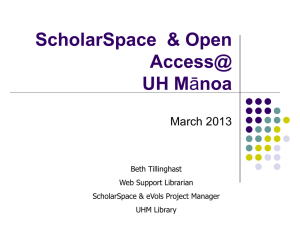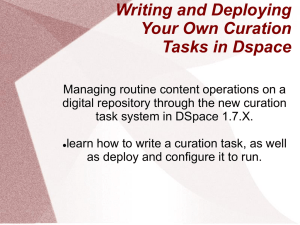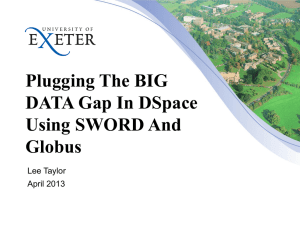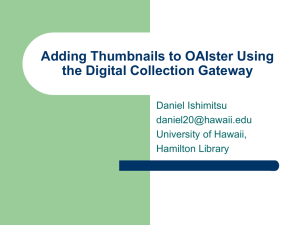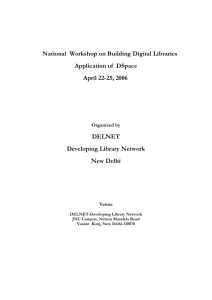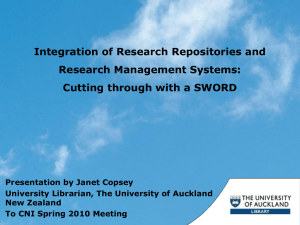2. Importance of Institutional Repositories - SLA
advertisement
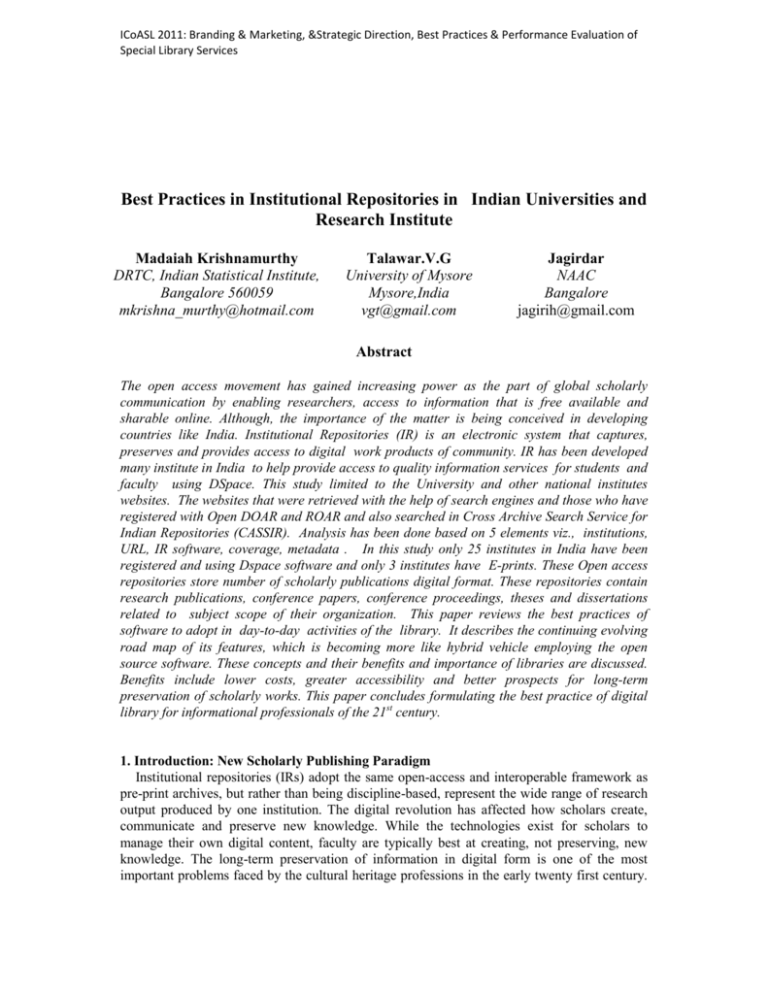
ICoASL 2011: Branding & Marketing, &Strategic Direction, Best Practices & Performance Evaluation of Special Library Services Best Practices in Institutional Repositories in Indian Universities and Research Institute Madaiah Krishnamurthy DRTC, Indian Statistical Institute, Bangalore 560059 mkrishna_murthy@hotmail.com Talawar.V.G University of Mysore Mysore,India vgt@gmail.com Jagirdar NAAC Bangalore jagirih@gmail.com Abstract The open access movement has gained increasing power as the part of global scholarly communication by enabling researchers, access to information that is free available and sharable online. Although, the importance of the matter is being conceived in developing countries like India. Institutional Repositories (IR) is an electronic system that captures, preserves and provides access to digital work products of community. IR has been developed many institute in India to help provide access to quality information services for students and faculty using DSpace. This study limited to the University and other national institutes websites. The websites that were retrieved with the help of search engines and those who have registered with Open DOAR and ROAR and also searched in Cross Archive Search Service for Indian Repositories (CASSIR). Analysis has been done based on 5 elements viz., institutions, URL, IR software, coverage, metadata . In this study only 25 institutes in India have been registered and using Dspace software and only 3 institutes have E-prints. These Open access repositories store number of scholarly publications digital format. These repositories contain research publications, conference papers, conference proceedings, theses and dissertations related to subject scope of their organization. This paper reviews the best practices of software to adopt in day-to-day activities of the library. It describes the continuing evolving road map of its features, which is becoming more like hybrid vehicle employing the open source software. These concepts and their benefits and importance of libraries are discussed. Benefits include lower costs, greater accessibility and better prospects for long-term preservation of scholarly works. This paper concludes formulating the best practice of digital library for informational professionals of the 21st century. 1. Introduction: New Scholarly Publishing Paradigm Institutional repositories (IRs) adopt the same open-access and interoperable framework as pre-print archives, but rather than being discipline-based, represent the wide range of research output produced by one institution. The digital revolution has affected how scholars create, communicate and preserve new knowledge. While the technologies exist for scholars to manage their own digital content, faculty are typically best at creating, not preserving, new knowledge. The long-term preservation of information in digital form is one of the most important problems faced by the cultural heritage professions in the early twenty first century. ICoASL 2011: Branding & Marketing, &Strategic Direction, Best Practices & Performance Evaluation of Special Library Services Developments in information and communication hold great potential for the advancement of knowledge and the good human kind through the open access of scholarly literature. The Open access movement has gained increasing power as the part of global scholarly communication by enabling researcher’s access information that is freely available and sharable online. Institutional Repositories (IRs) are practical cost effective and strategic means for universities / institutions to build partnership with their faculty to advance scholarly communication. Recent advances in information technology have provided new ways of dealing with information in academic libraries. The explosion of the web, the Internet and information technology in general has created challenges and has provided huge opportunities for those working in library and information profession in higher education. Open source software has enabled those in many countries around the world to develop digital library systems and the open access movement provides researchers and students the accessibility to current literature and research outputs (Krishnamurthy, 2007). 2. Importance of Institutional Repositories IRs in universities generally include pre-prints of journal articles, seminar papers, technical reports, research data, theses, dissertations, work in progress, important print and image collections, teaching and learning materials, and other materials, documenting the history of the institution. For several years, universities and R& D institutions have been primarily responsible for creation of new knowledge by investigating activities. These are in the form of theses, dissertations, project reports, courseware, pre-prints, etc. These documents carries huge amount of valuable data and material which is probably not available in any published resource. Unfortunately these are inaccessible in the absence of appropriate mechanisms such as bibliographic control access. Even those resources that eventually appear in print and are published may still be in accessible to a vast majority of institutions due to the high cost of subscription to the source material in which they are published. IRs are widely seen as one way of enhancing wider access to research carried out using public funds while at the same time improve visibility of research especially for developing countries. Thus, for universities/institutions, IRs are marketing tools, communicating available expertise and quality by showcasing output of faculty and research scholars, public service projects, and other activities and collection. IRs also complements existing metrics for gauging institutional productivity and prestige. While the increased visibility reflects a high quality of scholarship, this demonstration that value can also translate into tangible benefits, including attracting funding from public and private sources increasing the institution’s status and reputation. With the availability of advanced information and communication technologies (ICTs) and by building up necessary infrastructure in India, particularly in academic institutes, this will become an active contributor to global open access literature. IRs in universities generally include pre-prints of journal articles, seminar papers, technical reports, research data, theses, dissertations, work in progress, important print and image collections, teaching and learning materials, and materials documenting the history of the institution. 3. Literature Review A general study reviews on Institutional Repositories in developing countries like India and its benefits have been provided by many authors. A recent study on open access initiatives in India-an evaluative by Liela Fernadez(2006) carried out briefly on implementation of Institutional Repositories in many organizations like IISc,(E-prints) INFLIBNET,(DSpace) Indian Statistical Institute,(DSpace) etc,. And the authors from these organizations have published articles on institutional repositories as case studies for their showcase of research output. Richard Johnson (2006) Director at the United Kingdom's scholarly publishing and ICoASL 2011: Branding & Marketing, &Strategic Direction, Best Practices & Performance Evaluation of Special Library Services Academic Resources Coalition (SPARC), defined a digital IR as “any collection of digital material hosted, owned or controlled, or disseminated by a college or university, irrespective of purpose or provenance. Kashimura (2007) describes digital archive is a system for preserving valuable digital information obtained by the digitization of cultural material in a secure and reliable manner and for using it effectively. Kaur (2007) says that, today, most of the cultural and heritage, materials are being converted into digitized forms to provide immediate accessibility anywhere in the world. One feature that all digital libraries share is a system of organization or management. Arms (2000) defines “digital library” to mean “a managed collections of information, with associated services, where the information is stored in digital formats and accessible over a network. Chang (2003) defines an institutional repository as a new method for capturing, collecting, managing, disseminating, and preserving scholarly publications created in digital form by the constituent members of an institution. The term was coined by Scholarly Publishing for Academic Resource Coalition (SPARC), and IR s have been defined by SPARC as 'digital collections capturing and preserving the intellectual output of a single or multi university community (Crow , 2002). The impetus for IR could be said to have emerged the Open Archive Initiatives (OAI) in 1999. This application to institutional archives, or repositories, was reinforced with the emergence of IR software. A large number of repositories have been built using software such as E-prints, DSpace and other software in India and many of the studies on IR carried out to evaluate studies on IR in India (Ghosh and Das, 2007). It provides insight of the status on Institutional Repositories. 4. Application of ICT in India Rapid advances in ICTs and its applications are dramatically affecting economic and social activities, as well as the acquisition, dissemination and use of knowledge (Carlo and Utz, 2005). The use of ICTs is reducing transaction costs and lowering the barriers of time and space, allowing the mass production of customized goods and services. With ICT use becoming all pervasive and its impacts are transformational, it has become an essential backbone of the knowledge society. The information infrastructure in a country consists of telecommunication networks, strategic information systems. India, thus, has already developed a vision and strategies to address its transition to the knowledge society. In the main, its initiatives have however, largely been developed around three functional pillars of the knowledge economy (education, innovation, and ICTs). Innovation system plays an important role in acquiring, creating, adopting, and disseminating knowledge, which is crucial for success in the knowledge society (Carlo ,D and Anuja, U 2005). The innovation system in any country consists of institutions, and procedures that affect how the country acquire, creates, dissemination, and use knowledge. Keeping in mind a few institutions have been built repositories using software such as Dspace, E-prints, and GSDL and other software in India. 5. Scope and Methodology This study is limited to the websites of University and other national institutes. The websites were retrieved with the help of search engines; those which were registered with Open DOAR and ROAR and were also searched in Cross Archive Search Service for Indian Repositories (CASSIR). Five elements have been considerd for analysis, i.e., institutions, URL, IR software, coverage, metadata. In this study, it was observed that only 25 institutes in India have been registered and using Dspace software and 3 institutes are E-prints. Some of the institutes like ISRO, ECIL and other defense organizations are on intranet (See Table 1&2).These Open access repositories store number of scholarly publications in digital format. Thus, CASSIR serves a functionality of cross searching of repositories. These repositories ICoASL 2011: Branding & Marketing, &Strategic Direction, Best Practices & Performance Evaluation of Special Library Services contain research publications, conference papers, conference proceedings, theses and dissertations related to subject scope of their organization. 5.1. Salient Features DSpace is a digital library system designed to capture, store, index, preserve, and to redistribute the intellectual output of a university’s research faculty in digital formats (www.dspace.org). It was developed jointly by Hewlett Packard (HP) Laboratories and Massachusetts Institute of Technology libraries. The DSpace architecture consists of three layers: application layer; business layer; storage layer. The application layer covers the interface to the systems, the web and user and interface and batch loader, in particular. The business layer contains the DSpace specific functionality, work flow, content management, administration, and search and browse modules. The storage layer was implemented using the relational database management system Postgre SQL. Each module has a well-documented API and all original code in the Java programming language. The other technological infrastructure includes a web server and Java servlet engine (Apache and Tomcat, both from the Apache Foundation); Jena (an RDF toolkit from HP labs), and OAICat (from OCLC). The system is available on Source Forge, linked from both the DSpace informational website and the HP labs site (Smith et al., 2003). Sutradhar (2006) describes the development of an institutional repository at the Indian Institute of Technology at Kharagpur using DSpace. OpenDOAR provides details of 243 repositories worldwide using DSpace. Most are in the US (52), Japan (47), the UK (23), India (14) and the rest in other countries. Interestingly, Sutradhar (2006) in his study pointed out that that of the total 243 repositories of the world , there were only 14 (6%) repositories developed in India. However, the present study finds that the number has significantly increased to 29. The salient feature and other characteristics of the IRs are as follows. 6. Analysis In this study we have studied 29 repositories, which stored publications such as journal articles, case studies, conference paper, conference proceedings, research reports, books and learning materials. The ETD @ IIsc is an institutionally acclaimed open access theses and dissertations repository of the Indian Institute of Science, a joint service of the National Centre for Science Information (NCSI) and the IISC library. It stands 82nd rank in world repositories. This repository disseminates and preserves high quality theses of the Indian Institute of Science. This repository is compliant to OAI-PMH (Protocol for Metadata Harvesting) and indexed in the CASSIR (Cross Archive search service for Indian Repositories), OAIster and OpenDOAR (Directory of Open Access Repositories). The record display page of individual theses provides links to full-text objects, along with descriptive metadata, such as title, author, subject, keywords, date of submission, publisher, abstract, URL, and the name of the collection. Indian Statistical Institute, Librarian’s Digital Library deals collections of Library and Information Science stands 180th rank of world repositories which covers, collection of papers, presentation and abstract of library and Information Science. The Search Digital Libraries (SDL) is a metadata harvesting service for open access repositories in the area of Library and Information science. The National Institute of Technology Rourkela, one of the national Institutes of Technology in the country, is engaged in higher education and research activities in the areas of engineering, technologies and applied sciences. This institute’s repository collects preserves and disseminates intellectual outputs of the host institution to the global audience. At present it preserves conference papers, journal articles, preprints and theses ICoASL 2011: Branding & Marketing, &Strategic Direction, Best Practices & Performance Evaluation of Special Library Services authored by NITR researchers and faculty members. This repository is compliant to OAI-PMH and indexed in the CASSIR , OAI DOAR . Regarding IITs , these repositories strive to become a reliable and open access scholarly communication channels for disseminating publications produced by the research community in this institutes.. The subject coverage of this repository is applied science, engineering and technology areas. The Indian Institute of Astrophysics (IIAP) is a premier research institution devoted to research in astronomy, astrophysics and related physics. It stands 218th rank in the world repository. The IIAP repository is the open access institutional repository, developed to capture, disseminate and preserve research publication of the IIAP. It includes old records, manuscripts, publications and photographs. This repository is compliant to OAI-PMH and indexed in the CASSIR, OAIster and OpenDOAR. The Indian Institute Management is involved in academic and sponsored research in the interdisciplinary areas of economics, management, trade, commerce, industries and related areas. This institutional repository provides open access archiving facilitates to the IIMK communities such as faculty member, students and researchers. It covers book reviews, case studies, journal articles, conference papers, working paper and conference proceedings in the areas of management, business, economics, communications and social science. The Raman Research Institute is a premier research centre in the area of physical science. The RRI Digital Repository is an institutional repository providing worldwide access to the research publications, contributed by the faculty members and scholars. It consists of the annual reports, lectures and newspaper clippings. This repository is compliant to OAI-PMH and indexed in the CASSIR, OAIster and OpenDOAR. The Information and Library Network (INFLIBNET) centre, India is an autonomous Inter University Centre of University Grants Commission, involved in creating information infrastructure for academic and research institutions, particularly for universities and colleges in India. This Institution repository contains proceedings of CALIBER and PLANNER. It also provides full text access to collections such as, dArchive India (Digital Academic and Research content for Value Education), news clippings about INFLIBNET, course materials, library automation materials. This IR also compliant with OAI-Metadata Harvesting Protocol. Most of these operate on UNIX/Linux operating system platform. Typical functionality supported by these systems includes; user registration; document submission; approval/moderation of submitted documents; archiving; dissemination; and administration. IRs are a practical, cost effective, and strategic means for universities to build partnership with their faculty to advance scholarly communication. According to Savenije (2010) IRs are built on growing faculty practices of posting research output online, often on personal websites, but also on institutional websites or in disciplinary repositories suggesting an increasing desire for expanded exposure of, and access to their work. Further, IRs allow universities to offer secure digital hosting and archiving services combined with more effective web dissemination, while the universities can benefit from the enhanced visibility of their research outputs and the prestige that this confers. Unfortunately, however, the growth of IRs in Indian universities has not been of the desired level and order. While the elite institutions such as IISc, the IITs and a few elite universities have been quick to build IRs, a very large number of universities, especially the state universities, colleges and institutions of higher education are yet to initiate any major action in building IRs. According to a recent paper (Tilak, Jandhyala B.G. 2009), there are as many as 421 universities (including deemed universities) and over 18000 colleges (including over 5000 professional colleges) in the country. Needless to say, that a substantial portion of research being carried out in these institutions remains inaccessible if efforts are not initiated to develop channels such as IRs to enhance the visibility of scholarly output of these institutions. There are several factors that have contributed to this state of affairs. Many of these universities and colleges may be lacking ICoASL 2011: Branding & Marketing, &Strategic Direction, Best Practices & Performance Evaluation of Special Library Services the expertise or resources it takes to initiate IRs. India is also a multilingual country with several scripts being used. A substantial amount of the research output in Indian universities is in the regional languages. Fortunately, today we have access to digital publishing technologies, global networking, enabling interoperability protocols and metadata standards, all of which have contributed to providing practical and cost-effective technical solutions that can be implemented even by small institutions. While institutional repositories centralize, preserve, and make accessible an institutions intellectual output, at the same time they also form a part of a global system of distributed, inter operable repositories providing the foundation for a new disaggregated model. Digital publishing and networking technologies harnessed by an increasingly dissatisfied library market as well as by authors themselves are now driving fundamental changes in universities. For countries such as India that are still far behind tapping into and making effective use of existing IR technologies. Table 1. IR Software used in India Sl N o 1 Institutions URL Aryabhatta Research Institute of Observational Science Asia Pacific Institute of Management Studies Bangabondhu Shekh Mujib Medical University Bangalore Management Academy Guru Gobind Singh Indraprastha University http://202.141.125.171:808 0/jspui/ Dspace Science and Technology OAI-PMH http://www.dspace.org/ww w.asiapacific.edu/ http://sunzil.lib.bku.hk/hkut o/index/jsp Dspace Management Studies Medical Science OAI-PMH http://www.bma.ac.in:8080 /dspace/ http://dspace.ipu.ernet.in:80 80/ Dspace Management OAI-PMH Dspace multidisciplin ary OAI-PMH 6 ICFAI business School, Ahmedabad http://202.131.96.59:8080/d space Dspace Management OAI-PMH 7 IGNCA Heritage OAI-PMH 8 Indian Institute of Astrophysics IIM ,Khozikode http://tdil.mit.gov.in/coilnet /ignca/ http://prints.iiap.res.in/ DSpace Astronomy OAI-PMH http://dspace.iimk.ac.in Dspace Management OAI-PMH OAI-ster Google,AR C (Unified Cross archive earch OAI-PMH 2 3 4 5 9 Software Dspace Coverage 10 Indian Institute of Science http://eprints.iisc.ernet.in/ E-prints Science and Technology 11 http://dspace.library.iitb.ac. in/dapce/ http://eprint.iitd.ac.in/ Dspace Engineering 12 Indian Institute of Technology, Mumbai IIT Delhi E-prints 13 Indira Gandhi Institute http://oii.igidir.ac.in:8080/d Dspace Engineering , allied science Economics Metadata OAI-PMH OAI-PMH OAI-PMH ICoASL 2011: Branding & Marketing, &Strategic Direction, Best Practices & Performance Evaluation of Special Library Services 14 15 of Development Research sapce and social science Indian Statistical Institute INFLIBNET(UGC) http://drtc.isibang.ac.in/ Dspace http://dspace.inflibnet.ac.in/ Dsapce Library and Inf Science Multi disciplinary OAI-PMH OAI-PMH Table 2. IR Software in India Sl No 16 Institutions URL Software Institute of Mathematical Science http://in.arxiv.org/ E-prints 17 NAL http://nal-ir.nal.res.in/ Dspace 18 NCCR,IIT Madras http://203.199.213.48 E-prints 19 National Institute of Technology, Rourkela http://dspace.nitrkl.ac.in/ds pace/ DSpace 20 National Chemical Laboratory http://dspace.ncl.res.in/dsp ace Dspace 21 National Institute of Oceanography http://drs.nio.org.drs Dspace 22 National Institute of Science Communication and Information Resources,New Delhi National Institute of Technology, Rourkela http://nsdl.niscair.res.in 24 25 Coverage Metadata Physics, mathematics, Computer Science Aero Engineering OAI-PMH Energy Sources, nano Materials Engineering/T echnology OAI-PMH Chemistry and Biological Science Marine science OAI-PMH Dspace Unknown OAI-PMH http://dspace.nitrkl.ac.in/ds pace/ DSpace Engineering/T echnology OAI-PMH Raman Research Institute, http://dspace.rri.res.in/ DSpace Physics, Astrophysics OAI-PMH School of Communication and Management Studies (SCMS) Cochin Sree Narayana Gurukulam College of Engineering http://dspace.scmsgroup.or g DSpace Management OAI-PMH http://dspace.sngee.ac..in Dsapce Engineering OAI-PMH 27 Thapar University,Patiala http://dspace.thapar.edu:80 80/dspace/ Dsapce Unknown OAI-PMH 28 University of Hyderabad http://www.diglib.uohyd.er net.in/dspace Dspace Multi disciplinary OAI-PMH 23 26 OOAI-PMH OAI-PMH OAI-PMH ICoASL 2011: Branding & Marketing, &Strategic Direction, Best Practices & Performance Evaluation of Special Library Services 29 University of Mysore http://dspace.vidyanidhi.or g/in:8080/dspace/ Dspace Multidisciplin ary OAIster- 7. Conclusion Open access to knowledge and information as we may see from this listing has far to go in India. With the availability of advanced information and communication technologies (ICTs) and by building up necessary infrastructure in India, particularly in academic institutes, this will becomes an active contributor to global open access literature. It is largely achievable is a country where policy frame works, institutional frameworks, information infrastructure, trained manpower, and financial resources are adequatelyavailable. The information infrastructure in a country consists of telecommunications network, strategic information systems, policy and legal frameworks affecting their deployment, as well as skilled human resources needed to develop and use it. To develop strong information infrastructure, it is necessary to mobilize the many stakeholders that are involved in its deployment and use; government, business, individual users, the telecommunications and information service providers and so on. IRs in universities generally include pre-prints of journal articles, seminar papers, technical reports, research data, theses, dissertations, work in progress, important print and image collections, teaching and learning materials, and materials documenting the history of the institution. Institutional Repositories (IR) are digital collections that capture and preserve the intellectual output of a single or multi- university community. IR s expands access to research, facilitate control over the research output of universities and institutions of national importance, and provide a sustainable management system for digital content. 8. References 1. Carlo, D and Anuja, U. India and the Knowledge Economy: Leveraging strengths and opportunities”, World Bank Institute,World Bank,2005. 2. Chang, S.H.“Institutional repositories: the library's new role”, OCLC Systems and Services. Vol 19 No.3. (2003): 77-79 3. Crow, R. “The case for institutional repositories: A SPARC position paper”, Washington, DC. The scholarly publishing and Academic Resource Coalition(2002). Available at : http://www.arl.org/spacr/IR/ir.html ( accessed 20 October 2009) 4. Davidson, J and Klaure, M. “Institutional Repositories: Their Emergence and Impact on Scholarly Publishing” (2006), Available at http://www.sheridanpress.com/assets/pdf/inst_repositories.pdf 5. Ghosh , S.B, Das, A.K. “ Open Access and Institutional Repositories -A Developing Country Perspective: a case study of India”, IFLA Journal, ( 2007): 229 -250 6. Johnson R (2002) Institutional Repositories: Partnering with Faculty to Improve Scholarly Communication, D-Lib Magazine, 8(11) .Available at http://www.dlib.org/dlib/november02/johnoson/11johnoson.html ( accessed 10 October 2009)., 7. Kashimura, M. “ Digital archiving of rare books by HUMI project: an introduction to the digital archives of rare books and their preservation”, Journal of Information science and Technology 57 (2) ( 2007): 89-93 8. Kaur, A “Preservation of Digital heritage materials”, SRELS Journal of Information Management, 44 (4) (2007):385-394 ICoASL 2011: Branding & Marketing, &Strategic Direction, Best Practices & Performance Evaluation of Special Library Services 9. Leila F. Open Access Initiative in India- an Evaluation. Partnership: the Canadian Journal of Library and Information Practice and Research,Vol.1. No.1. Available at : http://atrium.lib.uoguelph.ca:8080/xmlui/bitstream/handle/10214/93/172.pdf?sequence =1 ( accessed 20 October 2009) 10. Ranking web of World Repositories. Available at http://repositories.webometrics.info/top400_rep_inst.asp (accessed 20 January 2010) 11. Rekha Mittal and G Mahesh Digital libraries and repositories in India: an evaluative study”, Program: Electronic library and information systems, 42 (3) ( 2007): 296302. 12. Sen, B.K and Josaiah, J. Open Access to Knowledge and Information: Scholarly Literature and Digital Library Initiatives the south Asian Scenario, Unesco, New Delhi 2008. 13. Simpson, P. “Repositories for research: Southampton’s evolving role in the knowledge cycle”, Program: electronic library and information systems, Vol. 40 No. 3, (2006): 224-31. 14. Smith, M., Bass, M., McClellan, G., Tansley, R., Barton, M. and Branschofsky, M. “Dspace: an open source dynamic digital repository”, DLib Magazine, Vol. 9 No. 1, (2003), available at: www.dlib.org/dlib/january03/smith/01smith.html (accessed 24 November 2009) 15. Sutradhar, B. “Design and development of an institutional repository at the Indian Institute of Technology Kharagpur”, Program: Electronic library and information systems, Vol. 40 No. 3 (2006):244-55. 16. Tilak, Jandhyala B.G. “ Private sector in higher education: a few stylized facts”,. Social Change; March, Vol 39 No 1 ( 2009): 1-28
